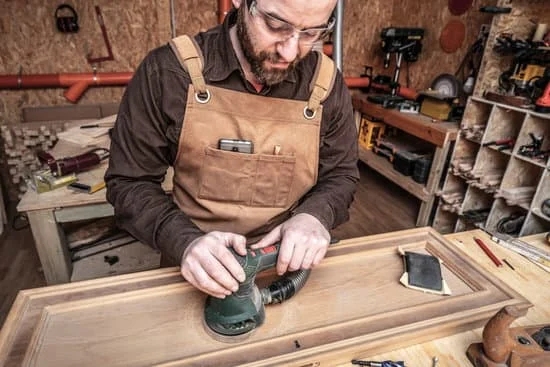Are you looking to enhance the look of your windows and give them a touch of elegance? In this article on “How to Window Woodwork Surround,” we will guide you through the process of creating stunning woodwork surrounds for your windows. These surrounds not only add aesthetic value to your space but also provide insulation and protection for your windows.
Window woodwork surrounds serve as decorative frames that highlight the beauty of your windows while also providing structural support. Whether you have a traditional or modern style of home, woodwork surrounds can be customized to complement the overall design aesthetic. By following our step-by-step guide, you can create custom window frames that add charm and character to any room in your home.
Before you begin this DIY project, it is essential to understand what a window woodwork surround is and the different types available. From traditional casings to more ornate designs, there are endless possibilities when it comes to choosing the perfect woodwork surround for your windows. With proper planning, preparation, and execution, you can transform your windows into focal points that reflect your personal style and creativity.
What Is a Window Woodwork Surround
A window woodwork surround, also known as a window casing, refers to the decorative frame that surrounds a window, typically made of wood. This element not only adds visual appeal to the window but also serves practical purposes such as concealing gaps between the window frame and the wall, as well as providing insulation and protection against moisture.
Window woodwork surrounds come in various styles and designs, allowing homeowners to customize their windows to complement the overall aesthetic of their space.
Types of Woodwork Surrounds
There are several types of woodwork surrounds for windows, each offering a unique look and feel. Traditional woodwork surrounds often feature intricate detailing such as crown molding, rosettes, and fluting, adding a touch of elegance to the window. Modern woodwork surrounds, on the other hand, tend to have clean lines and minimalist designs, perfect for contemporary or Scandinavian-inspired interiors. Additionally, craftsman-style woodwork surrounds emphasize simplicity and craftsmanship with exposed joinery and natural finishes.
Customization Options
One of the advantages of window woodwork surrounds is the ability to customize them according to personal preferences and design aesthetics. Homeowners can choose different types of wood (such as oak, pine, or cherry) for their surround based on durability and appearance.
They can also select various finishes like staining or painting to match existing interior decor or create a focal point within a room. Furthermore, customizing the size and shape of the surround allows for flexibility in accommodating different window sizes and styles in any home.
Benefits of Window Woodwork Surrounds
Window woodwork surrounds not only enhance the visual appeal of windows but also provide additional benefits such as improved insulation by sealing gaps and preventing drafts. The added layer of protection against moisture can help prolong the lifespan of both the window frame and surrounding wall materials.
Furthermore, installing a woodwork surround can increase the overall value of a home by upgrading its aesthetics and functionality. With proper care and maintenance, a well-crafted woodwork surround can last for years while maintaining its beauty and structural integrity.
Planning and Preparation
When embarking on a window woodwork surround project, proper planning and preparation are essential to ensure a successful outcome. Before diving into the actual construction process, it is crucial to gather all the necessary tools and materials needed for the project. The right tools will make the job easier and more efficient, while using quality materials will result in a durable and visually appealing woodwork surround.
Tools Needed
To start off, you will need a tape measure for accurate measurements, a pencil for marking the wood, a miter saw or circular saw for cutting the wood pieces, a drill with screwdriver bits for assembly, clamps to hold pieces together during construction, a level to ensure straight lines and angles, and sandpaper or a sander for finishing touches. Additionally, it is important to have safety equipment such as goggles and gloves to protect yourself during the woodworking process.
Materials Required
The materials needed for creating a window woodwork surround include lumber or plywood for the frame of the surround, trim pieces for decorative elements, screws or nails to secure the pieces together, wood glue to add extra strength and stability to joints, stain or paint for finishing touches, and any additional hardware such as brackets or hooks for installation. It is advised to choose high-quality wood that suits your style preferences and complements your existing interior design.
By carefully selecting the right tools and materials upfront, you can set yourself up for a smooth and successful window woodwork surround project.
Measuring and Marking
Once you have the measurements, mark the lengths of each piece of wood accordingly. Use a pencil to make clear marks on the wood where cuts need to be made. Double-check your measurements and markings before moving on to cutting the wood to avoid any mistakes that could affect the final fit of the surround. It’s always better to measure twice and cut once in woodworking projects like this.
To ensure symmetry and balance in your window woodwork surround, take extra care in marking where pieces will join together. Proper alignment is essential for a professional look once the pieces are assembled. Additionally, consider using a level during this step to ensure that all markings are straight and even. By taking your time with measuring and marking accurately, you set yourself up for success when it comes to constructing your window woodwork surround.
| Window Woodwork Surround Measurement Tips | Importance |
|---|---|
| Double-check measurements | Ensures accurate sizing |
| Use a level during marking | Achieves straight and even markings |
| Mark joining pieces carefully | Ensures symmetry and balance |
Cutting and Assembly
When it comes to creating a window woodwork surround, one of the key steps is cutting and assembling the pieces to fit perfectly around the window. This process requires precision and attention to detail to ensure a seamless finish. Here is a step-by-step guide on how to cut and assemble the woodwork for your window surround:
- Measure Twice, Cut Once: Before you start cutting the wood, make sure you have accurate measurements of the window opening. Double-check your measurements to avoid any mistakes.
- Selecting the Right Wood: Choose high-quality wood that is suitable for your project, such as pine or oak. Make sure the wood is straight and free of knots or imperfections.
- Cutting the Pieces: Use a table saw or circular saw to cut the wood into pieces according to your measurements. Be precise with your cuts and ensure that all pieces are identical in size.
Once you have cut all the necessary pieces, it’s time to assemble them to create the window woodwork surround. Follow these instructions for a smooth assembly process:
- Dry Fit: Before securing the pieces together, do a dry fit by placing them around the window opening without attaching them. This will help you ensure that everything fits properly.
- Glue and Nail: Apply wood glue along the joints where two pieces meet and use finishing nails to secure them together. Make sure to use clamps to hold everything in place while the glue sets.
- Fill in Gaps: Use wood filler to fill in any gaps or holes between the joints. Sand down any rough edges for a flawless finish before moving on to staining or painting.
By following these instructions on cutting and assembling your window woodwork surround, you can create a beautiful frame that adds elegance and charm to your windows while also enhancing your home’s overall aesthetic appeal.
Finishing Touches
When it comes to finishing touches on your window woodwork surround, sanding, staining, and painting are crucial steps to enhance the appearance of the final product. Here are some tips and tricks to help you achieve a professional finish for your project:
- Sanding: Before applying any finish, it’s important to sand the woodwork surround to smooth out any rough edges or imperfections. Start with a coarse-grit sandpaper to remove any excess material and then work your way up to a finer grit for a smooth finish.
- Staining: Staining is a great way to add color and depth to your woodwork surround. Before staining, make sure the wood is clean and free of dust. Apply the stain with a brush or cloth in the direction of the grain, allowing it to penetrate the wood for a rich finish. Consider testing the stain on a small piece of scrap wood first to ensure you achieve the desired color.
- Painting: If you prefer a painted finish for your window woodwork surround, choose a high-quality paint that is suitable for wood surfaces. Before painting, use a primer to seal and prepare the surface for better adhesion. Apply thin layers of paint with a brush or roller, allowing each coat to dry completely before adding another layer.
By following these sanding, staining, and painting tips, you can bring out the natural beauty of the wood and create a stunning window woodwork surround that complements your home’s aesthetic.
Remember that proper preparation and attention to detail are key when it comes to finishing touches on woodworking projects. Take your time during this step of the process as it can make all the difference in achieving a professional-looking result.
In addition, don’t hesitate to get creative with different finishes or techniques such as distressing or antiquing for a unique look. Experimenting with various stains or paints can help you customize your window woodwork surround to match your personal style and preferences.
Installation Process
Installing a window woodwork surround can add a beautiful and polished look to any room in your home. Before beginning the installation process, it is essential to ensure that the surrounding area is clean and free of any debris or dust. Start by measuring the dimensions of your window frame accurately to ensure that the woodwork surround will fit perfectly.
Next, gather all the necessary tools and materials for the installation, including a tape measure, level, screws or nails, drill, wood glue, and paint or stain for finishing touches. It is important to use high-quality materials to ensure durability and longevity of your woodwork surround.
Begin by attaching the side pieces of the surround to the window frame using wood glue and screws or nails. Use a level to ensure that the pieces are straight and secure. Then, attach the top piece of the surround in the same manner.
Once all pieces are securely attached, fill any gaps or holes with wood filler and sand down any rough edges for a smooth finish. Finally, finish off by painting or staining the woodwork surround to match your existing decor.
By following these steps on how to properly install a window woodwork surround, you can achieve a seamless finish that enhances the overall aesthetic appeal of your space. Remember to take your time during each step of the installation process and pay attention to detail for professional-looking results. With proper care and maintenance, your newly installed woodwork surround will continue to impress for years to come.
Maintenance and Care
Maintaining and caring for your window woodwork surround is essential to ensure its longevity and durability. Proper maintenance not only keeps the woodwork looking good but also helps to protect it from damage over time. Here are some important tips on how to effectively maintain and care for your woodwork surround.
First and foremost, regular cleaning is crucial to keeping your window woodwork surround in excellent condition. Dust and dirt can accumulate on the surface, so make sure to dust the wood regularly with a soft cloth or duster. For deeper cleaning, use a mild wood cleaner and a damp cloth to wipe down the surfaces, making sure to dry them thoroughly afterwards.
In addition to regular cleaning, it is important to inspect the woodwork surround periodically for any signs of damage or wear. Look out for any cracks, chips, or discoloration in the wood, as these could indicate potential issues that need to be addressed. If you spot any damage, be sure to repair it promptly to prevent further deterioration.
Another key aspect of maintaining your window woodwork surround is protecting it from moisture and humidity. Wood is susceptible to warping and rotting when exposed to excessive moisture, so make sure that the area around your windows is well-ventilated.
Additionally, consider applying a protective finish or sealant to the woodwork surround to help repel moisture and prolong its lifespan. By following these maintenance tips, you can keep your window woodwork surround looking beautiful and in top condition for years to come.
Inspiring Design Ideas
Window woodwork surrounds are not only functional but can also add charm and character to any home. When it comes to designing window woodwork surrounds, there are endless possibilities to explore. One creative design idea is to incorporate intricate woodworking details such as carved motifs or decorative trim pieces. These ornate touches can elevate the overall look of the window surround and create a focal point in the room.
Another inspiring design idea for window woodwork surrounds is to play with different wood stains and finishes. By mixing and matching various wood tones, you can achieve a unique and custom look that complements your existing decor. For a more modern touch, consider using sleek and minimalist designs with clean lines and geometric shapes. This will give your window woodwork surround a contemporary feel while still retaining its timeless appeal.
For homes with larger windows, consider creating a grandiose window surround with built-in shelving or storage options. This multifunctional design not only adds visual interest but also provides practical solutions for maximizing space. Additionally, incorporating stained glass panels or frosted glass inserts into the window surround can bring in natural light while adding a touch of elegance to the overall design.
| Design Idea | Description |
|---|---|
| Intricate Woodworking Details | Incorporate carved motifs or decorative trim pieces for an elegant look. |
| Mixing Wood Stains | Experiment with different wood tones for a custom finish that complements your decor. |
| Built-in Shelving | Create a multifunctional design with storage options built into the window surround. |
Conclusion
In conclusion, mastering the art of window woodwork surrounds can truly elevate the aesthetics of any home. By creating a custom woodwork surround for your windows, you not only add a touch of elegance and sophistication but also increase the overall value of your property. The process may seem daunting at first, but with the right tools, materials, and guidance, anyone can successfully tackle this DIY project.
Throughout this article, we have discussed the importance of proper planning, precise measuring and marking, accurate cutting and assembly techniques, as well as finishing touches to enhance the appearance of the woodwork surround. Additionally, we have provided insights on how to properly install and maintain these surrounds to ensure their longevity and durability.
We hope that this guide has inspired you to explore your creative side and try your hand at window woodwork surrounds. Whether you are a seasoned DIY enthusiast or a novice looking for a new project to tackle, creating custom woodwork surrounds for your windows can be a rewarding experience. So gather your tools, choose your favorite design inspiration, and embark on this journey to enhance the beauty of your home through stunning window woodwork surrounds.
Frequently Asked Questions
Should You Put Trim Around Windows?
Putting trim around windows can enhance the overall appearance of a room by adding visual interest and creating a finished look. It can also help hide any gaps between the window frame and the wall, providing a more polished aesthetic. Additionally, trim can protect the edges of windows from potential damage.
What Is Woodwork Around Windows Called?
The woodwork around windows is typically referred to as window casing or window trim. This trim is not only decorative but also serves a functional purpose by concealing any gaps between the window frame and the wall. Window casing comes in various styles and materials, allowing for customization based on personal preference and home decor.
Do You Caulk Between Window and Trim?
Caulking between the window and trim is generally recommended to prevent drafts, moisture intrusion, and heat loss. This sealing technique helps improve energy efficiency by creating a tight seal that blocks out air leaks and water infiltration. Properly caulking along the edges of windows also aids in maintaining a consistent indoor temperature while reducing energy costs over time.

Hi everyone! I’m a woodworker and blogger, and this is my woodworking blog. In my blog, I share tips and tricks for woodworkers of all skill levels, as well as project ideas that you can try yourself.





